This article provides a brief overview of architectural symbolism in ancient Rome, highlighting the importance of studying Roman temples and monuments as cultural artifacts that reflect the values and beliefs of Roman society.
The architecture of ancient Rome was not just about aesthetics; it was deeply intertwined with the daily life, social class divide, and legal systems of the time. For instance, exploring daily life in ancient Rome reveals how vastly different experiences were for various social classes, which is often reflected in the architecture they inhabited. Similarly, understanding how the Twelve Tables shaped Roman legal systems can provide insights into the societal values that influenced architectural design.
Furthermore, Roman architecture also played a significant role in the spectacle of ancient Rome, serving as a backdrop for various entertainment forms like gladiatorial games and chariot races.
The key takeaway from this article is an exploration of the rich symbolism embedded in Roman architecture, with a particular focus on temples and monuments. These structures not only served religious and political purposes but also continue to influence modern architectural practices. As we delve deeper into this topic, we will also touch upon other aspects such as the rise and fall of the Roman Empire and Roman roads, which further illustrate the significance of Roman architecture in shaping history.
Historical Context of Roman Architecture
The history of Roman architecture reflects a dynamic evolution from humble beginnings to monumental achievements. This evolution is intricately linked with the broader historical context of Ancient Rome, which includes the transition from the Roman Republic to the Roman Empire.
Early Influences: Etruscan and Greek
Early Roman structures drew heavily from Etruscan architectural elements, characterized by temple designs with high podiums and deep porches. This foundation was soon enriched by Greek influence on Roman architecture, especially through the adoption of classical orders—Doric, Ionic, and Corinthian columns—which became staples in temple facades and public buildings.
The Birth of a Distinctive Style
The integration of Greek classical orders with Etruscan traditions created a distinctive Roman style. For example:
- Temples combined the Etruscan emphasis on frontal approach and elevated platforms with Greek column arrangements.
- Monumental arches and porticos displayed refined aesthetics while serving functional purposes.
Innovations that Redefined Possibilities
Roman innovations transformed architectural possibilities. The introduction of opus caementicium (Roman concrete) allowed for unprecedented structural flexibility and durability. Concrete enabled architects to experiment with new forms such as vaults, domes, and expansive interiors not possible with traditional stone construction.
The use of arches revolutionized building techniques, distributing weight efficiently and permitting larger spans in bridges, aqueducts, amphitheaters, and basilicas. These advances supported the grandeur that symbolized Rome’s power and engineering mastery.
Symbolism in Stone: Temples and Monuments
This blend of inherited styles with innovative materials laid the groundwork for temples and monuments to become powerful symbols reflecting religious devotion, political authority, and technological progress in Roman society. The religious practices during this period were not merely a set of beliefs but a comprehensive system that intertwined with every aspect of their lives. Additionally, agriculture played a crucial role as a driver of Rome’s economic growth during both the Republic and Empire periods, extending beyond mere food production into a sector that significantly influenced social development (From Fields to Fortune: The Role of Agriculture in Roman Economic Growth).
Understanding these multifaceted aspects of Roman history not only enriches our knowledge about its architectural marvels but also provides valuable insights into the socio-political and economic structures that shaped Ancient Rome’s identity. For more extensive information on these topics, Men of Pompeii serves as an ultimate online resource dedicated to exploring the fascinating world of Ancient Rome from its origins as a Republic to its transformation into a mighty Empire.
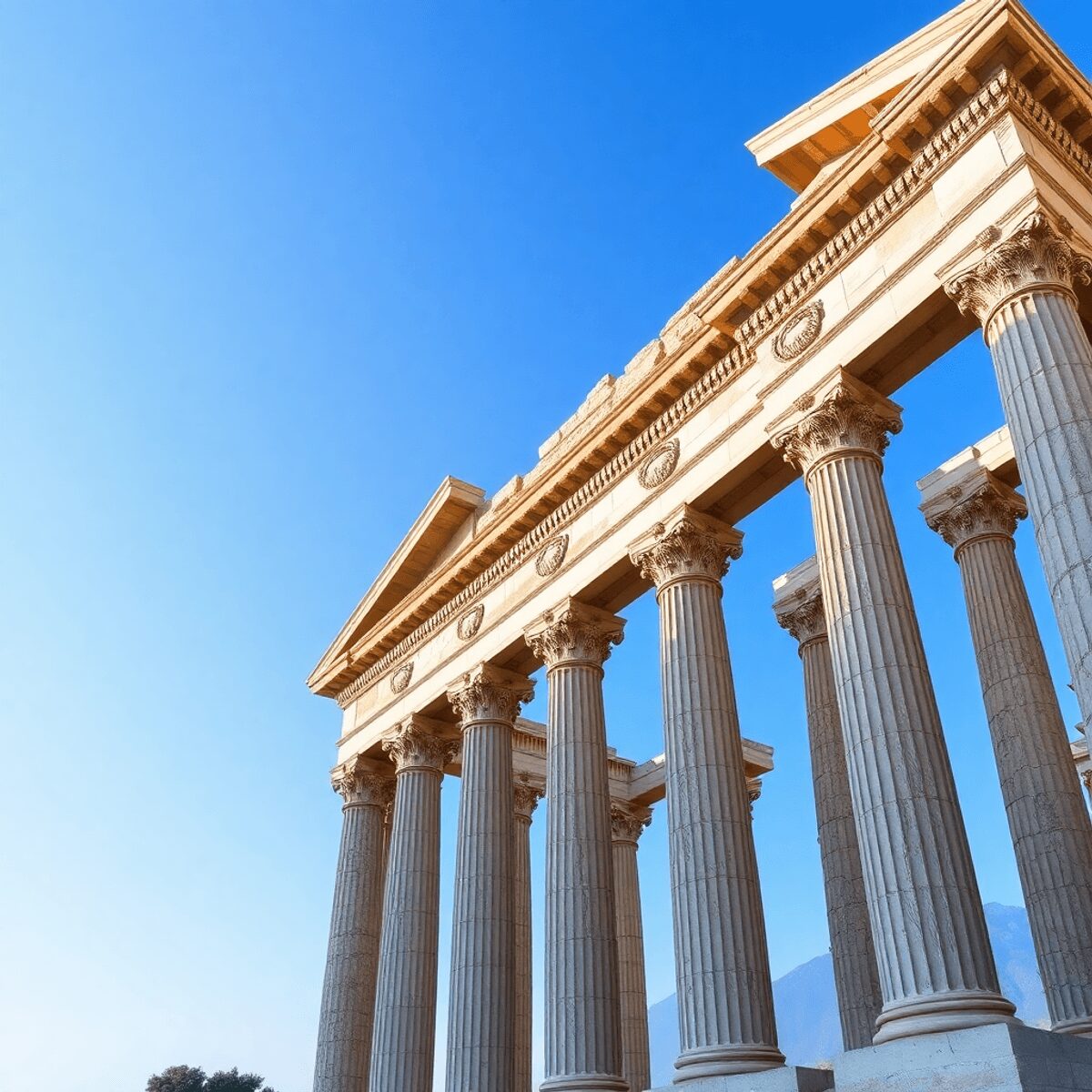
Symbolism in Roman Temples
Roman temples were more than just places to worship; they were designed with religious symbolism in architecture that conveyed Rome’s spiritual beliefs and its relationship with the divine. These sacred spaces were meticulously crafted to pay tribute to gods and goddesses, serving as central locations for rituals, offerings, and ceremonies that strengthened religious devotion and maintained social harmony.
Religious Significance of Temples
Temples represented the physical embodiment of the gods’ presence on earth. Their positioning, alignment, and layout adhered to strict religious principles to ensure harmony with celestial forces and divine intentions. The elevated platform of the temple symbolized a distinction from the earthly realm, forming a boundary between humanity and the sacred domain. Within the inner sanctuary known as the cella, statues of deities were housed, inviting worshippers into a space brimming with spiritual energy.
Architectural elements carried specific layers of meaning:
- Columns: Beyond providing structural support, columns symbolized stability, order, and the connection between heaven and earth. Different classical orders conveyed distinct symbolic significance.
- Pediments: Often adorned with sculptural reliefs depicting mythological scenes or divine figures, pediments narrated stories that reinforced religious convictions.
- Porticos: The grand entrance conveyed both hospitality and reverence, guiding visitors into a place set apart from everyday existence.
Classical Orders in Temples
Roman temple symbolism was intricately linked to the use of classical orders—Tuscan, Ionic, Corinthian, and Composite—each evoking different qualities:
- Tuscan order: Simple and robust, it reflected strength and humility often associated with early Roman values.
- Corinthian order: Elaborate capitals embellished with acanthus leaves symbolized abundance and divine beauty.
- Composite order: A Roman innovation combining Ionic volutes with Corinthian foliage, it embodied imperial grandeur and cosmopolitan influence.
These orders were deliberately chosen; they enhanced the temple’s message about which deity was honored and what virtues were celebrated.
Case Study: The Pantheon
The Pantheon stands as an iconic example of architectural symbolism in Roman temples. Its design merges religious purpose with unprecedented engineering innovation. Constructed during Emperor Hadrian’s reign (circa 126 AD), the Pantheon’s most striking feature is its massive unsupported concrete dome—a revolutionary achievement at the time that exemplifies some of the incredible Roman engineering feats which have had a lasting impact on future generations.
Architectural Innovation
- The dome spans 43.3 meters (142 feet) in diameter without internal supports.
- Use of lightweight concrete mixes reduced stress on the structure.
- Coffered ceilings minimized material weight while adding decorative rhythm.
- An oculus at the center opens directly to the sky.
This engineering marvel not only showcased Roman technological prowess but also served profound symbolic functions.
Dome Symbolism
The dome represented the heavens—a celestial canopy under which all gods resided. The open oculus allowed natural light to flood the interior, shifting throughout the day to create a dynamic interplay of illumination that suggested divine presence moving across time. Rain falling through this aperture was quickly drained away beneath the floor, symbolizing purity and renewal.
Worshippers entering this space experienced a sense of transcendence. The harmonious proportions and vast openness inspired awe and contemplation of Rome’s connection to cosmic order.
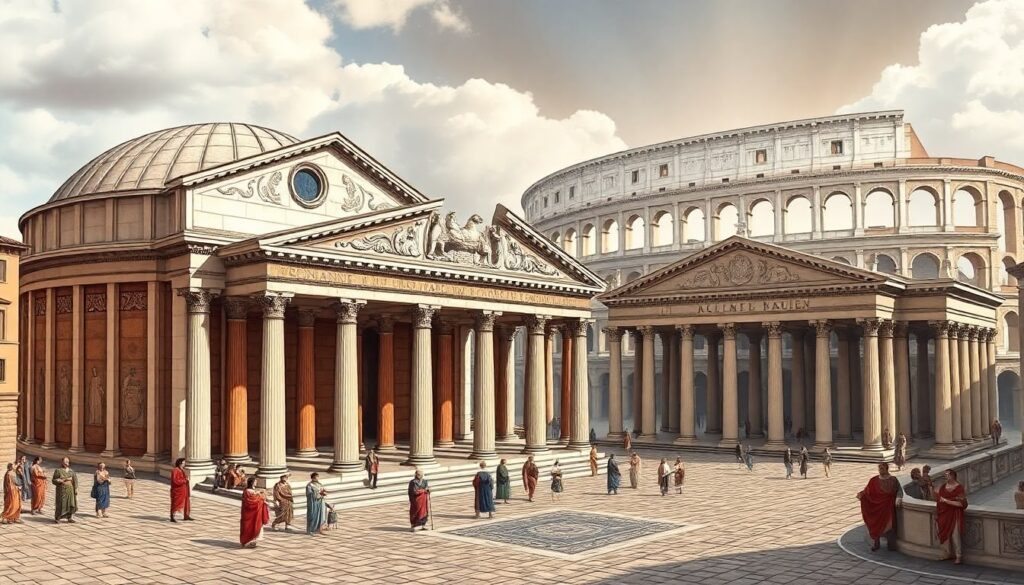
Symbolism in Roman Monuments
Roman monuments were more than just buildings; they represented the military power, victories, and strength of the empire. One type of monument that played a significant role in conveying messages of imperial propaganda through their design was the triumphal arch.
1. Triumphal Arches as Symbols of Victory
These grand arches were built to honor important military victories. They served as physical reminders of Rome’s conquests and superiority over its foes. A notable example of such military success can be seen in the accomplishments of Scipio Africanus, whose triumphs during the Second Punic War solidified Rome’s power.
2. Imperial Propaganda Through Architecture
The design of triumphal arches included intricate sculptures and inscriptions that praised the achievements of emperors and their armies. These decorative features acted as visual stories, conveying political messages that reinforced the authority and influence of those in power.
3. Symbolic Representation
Triumphal arches not only honored specific victories but also represented the grandeur of the empire and its divine right to rule. Their imposing presence in important locations within cities asserted Roman authority and projected an image of strength and invincibility. This image was often supported by the might of the Roman Army, which played a crucial role in achieving victories across vast territories.
The strategic placement, elaborate decoration, and symbolic meaning behind triumphal arches made them powerful tools for shaping public perception and reinforcing the beliefs that underpinned the Roman Empire. Additionally, these monuments often reflected broader cultural influences, such as those from Roman mythology, which have had a lasting impact on modern culture. Furthermore, they also serve as a reminder of the complex societal structures within Rome, including the role of gladiators who were both admired for their bravery yet also victims of a harsh social system.
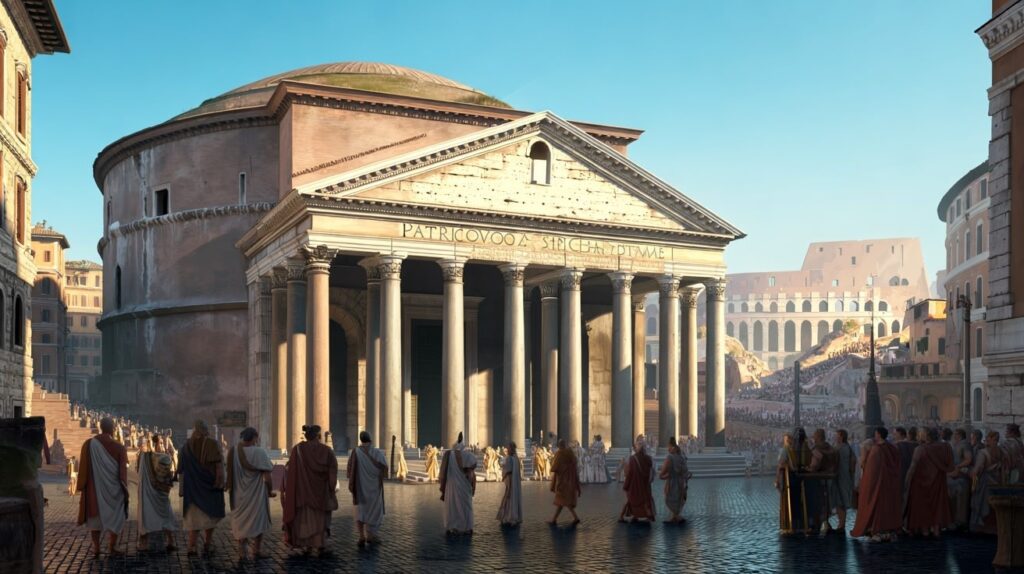
Civic Architecture and Its Symbolic Meaning
The symbolism of Roman public buildings was closely connected to the roles these spaces played in everyday life and government activities.
Basilicas: Embodying Law and Order
Basilicas were more than just large halls; they represented the idea of law and order. These structures hosted legal proceedings, commercial transactions, and public meetings, symbolizing the authority of Roman law. Their grand size, central position in forums, and architectural features like colonnades and clerestory windows emphasized the importance of transparency and civic duty. The design of the basilica—long rectangular halls with aisles—facilitated organized gatherings, reflecting the systematic nature of Roman judicial and administrative systems.
This structured nature can be traced back to Roman Law, which has played a crucial role in shaping modern legal systems. The principles established during this period are still relevant in various legal systems today. The legacy of this era is also reflected in the Corpus Juris Civilis, a significant achievement commissioned by Emperor Justinian I that not only preserved ancient Roman legal principles but also adapted them to the needs of contemporary society.
Amphitheaters: Reflecting Social Hierarchy and Unity
Amphitheaters carried a distinct symbolic weight as venues for public spectacle. Gladiatorial games, animal hunts, and theatrical performances staged in these arenas mirrored the social hierarchy of Rome while promoting unity among citizens through shared experience. The tiered seating arrangement physically manifested societal stratification yet also illustrated collective identity under Roman rule.
The Colosseum stands as the most iconic example where amphitheaters symbolism is unmistakable: it was a tool for emperors to demonstrate power, entertain masses, and project imperial ideology. These public buildings functioned as both practical spaces and powerful symbols expressing Rome’s values—justice through basilicas and social cohesion through amphitheaters.
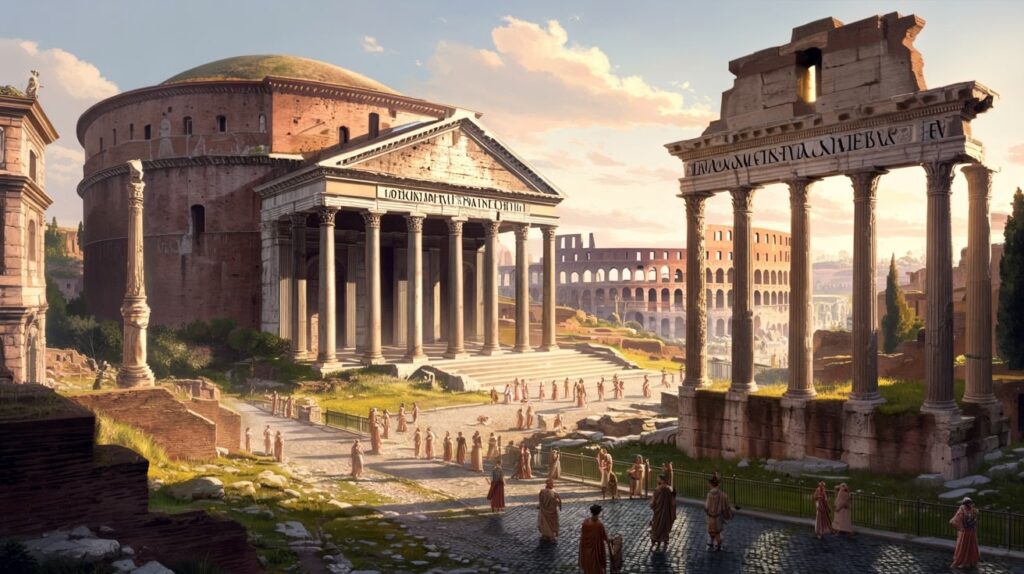
Cultural Identity Through Architectural Symbolism
Roman architecture served as a powerful medium to express cultural identity in Roman architecture by embodying the empire’s core values: power consolidation, religious unity, and social cohesion. Temples and monuments were not mere structures; they were deliberate symbolic representations designed to communicate Rome’s dominance and divine sanction across its vast and diverse population.
Key Elements of Architectural Symbolism
The following key elements reinforced the symbolism in Roman architecture:
- Scale: Monumental size projected authority and grandeur. The imposing height of temples like the Temple of Jupiter Optimus Maximus or the expansive footprint of forums conveyed Rome’s supremacy and unchallengeable power.
- Decoration: Sculptural reliefs, intricate friezes, and elaborate columns showcased artistic mastery while narrating stories of military triumphs, divine favor, and imperial lineage. These decorations functioned as visual propaganda reinforcing loyalty to the state and gods.
- Site Selection: Strategic placement of temples and monuments within city centers or along key processional routes emphasized their significance. Locations like the Roman Forum became epicenters of political, religious, and social life, symbolizing the unity between civic governance and divine order.
This careful orchestration of architectural features created an environment where citizens constantly encountered symbols that affirmed Rome’s cultural values. The blend of religious motifs with imperial iconography promoted a collective identity rooted in reverence for tradition, law, and conquest.
Architectural Symbolism in Roman Temples and Monuments thus transcended aesthetics—it was an essential tool for cultivating civic pride and imperial ideology. Through form, decoration, and context, these buildings narrated Rome’s story as a powerful empire blessed by the gods and united under shared cultural ideals.
To fully appreciate this architectural grandeur, one might consider exploring Ancient Rome, which was not merely an empire but a hub of innovation, culture, and governance that has left an indelible mark on history. Understanding this cultural context also requires delving into the lives of different social classes such as the plebeians, who formed the backbone of Roman society or the patricians, the wealthy elite who wielded significant power.
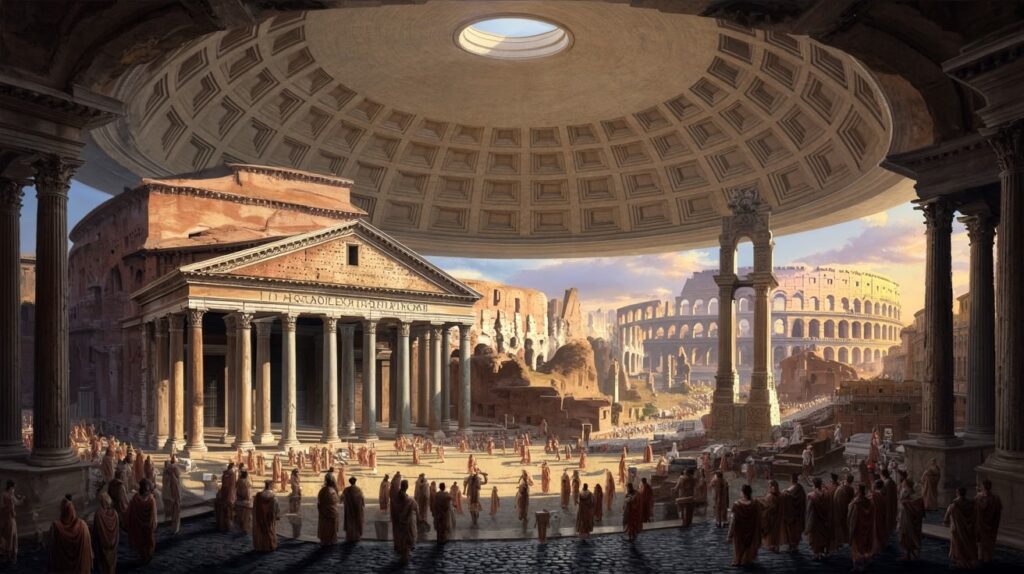
Enduring Legacy of Roman Architectural Symbolism
The significance of Roman architectural symbolism is evident in the way these ancient structures convey religious devotion, political power, and cultural identity. Roman temples and monuments functioned not only as physical spaces but also as powerful narratives expressing imperial authority, divine favor, and social order. The integration of innovative engineering with symbolic design created environments where the sacred and civic intertwined seamlessly.
Key elements such as the Pantheon’s dome symbolize cosmic harmony, while triumphal arches immortalize military victories through detailed reliefs and inscriptions. Basilicas and amphitheaters reinforced societal structure by embodying law, unity, and public spectacle.
The legacy of Roman architecture continues in modern architectural practices. Many contemporary public buildings borrow from Roman spatial organization, monumental scale, and symbolic motifs to evoke awe and communicate cultural values. This enduring influence highlights how architectural symbolism in Roman temples and monuments transcends time—bridging past ideals with present-day expressions of power, faith, and community identity.
Moreover, the impact of Roman culture extends beyond architecture; it has shaped various aspects of modern society. The legacy of Ancient Rome remains a cornerstone of Western civilization.
In terms of societal structure, it’s essential to acknowledge the legal status of Roman women, which reflects a complex interplay of rights and restrictions that significantly influenced gender dynamics in ancient Rome.
Additionally, the philosophical landscape during this period was profoundly affected by the rise of Stoicism, a school founded in ancient Greece that emphasized living in harmony with nature and using reason as paths to achieving human flourishing. These ideas became popular in Roman culture, influencing important thinkers throughout the empire.

